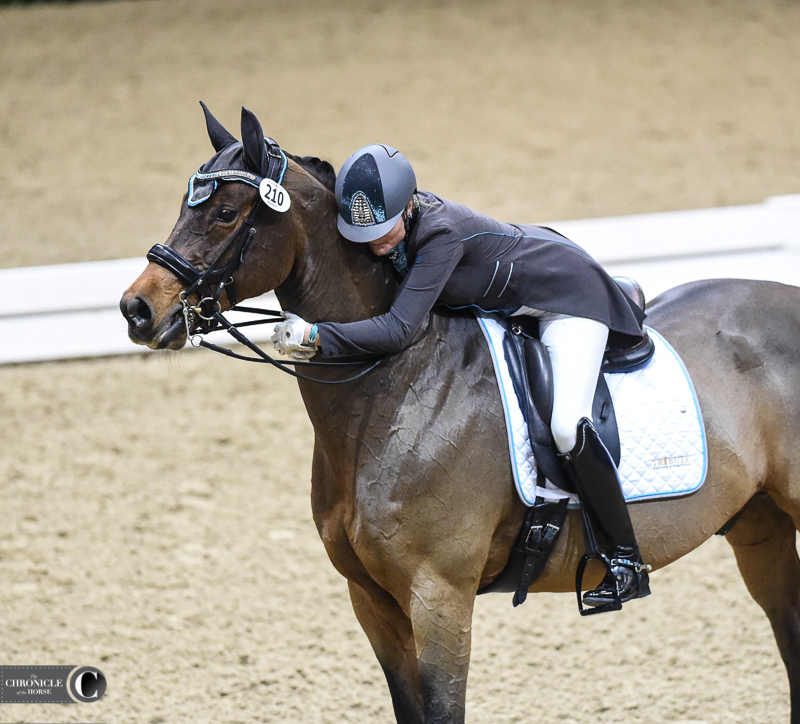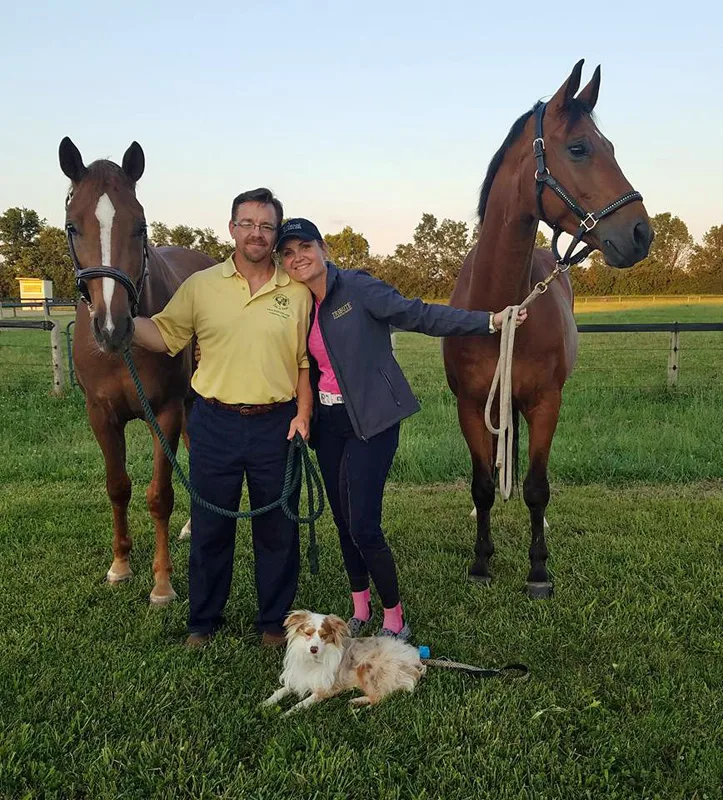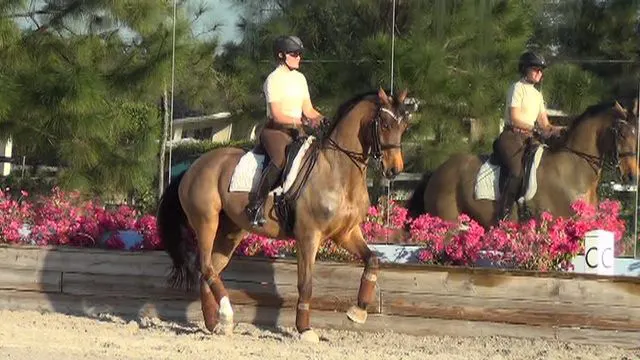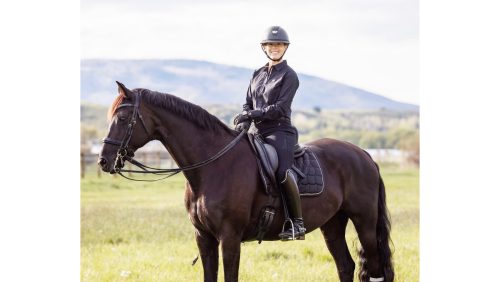The first time Jennifer Sappington Truett turned out Lafayette HQ, he spun off into a bucking, twisted caper across the field.
As she watched, she said to her groom with a laugh, “I do not want to ride that!”
“Taffy” was part of a string of sale horses breeder Suzanne Quarles sent to Truett’s Dancing Horse Farm in Lebanon, Ohio, in 2009. After a few years without a regular young horse trainer, Quarles needed to move some young stock and called up Truett.
Taffy, 7, barely qualified as young, but the few months he’d logged under saddle had mostly been completed as a 3- and 4-year-old. At 4, the Hanoverian gelding (Loerke—Rena, Raphael) escaped his stall and caught his left hind leg in the tongue of a manure spreader, and he’d spent the following three years at pasture.
“[He] had become significantly asymmetric with at least a foot of difference between the length of his stride on his strong side and the one with the injured leg,” said Truett. “He had a twisted pelvis, atrophied muscles all along the side he injured, and all these compensation patterns for protecting that injured leg.”

Lafayette HQ transformed from a project with a lot of baggage to Jennifer Truett’s Grand Prix horse. Lindsay Berreth Photo
A former competitor in eventing, driving and dressage to the FEI Young Rider level, Truett had left a successful career as a defense contractor to open a dressage training facility three years prior. Her reputation had been built on green horses and rehab projects, including her first FEI horse Lydia, whom she trained through Prix St. Georges before losing her to laminitis a month before Taffy arrived.
Beyond his physical impairments, Taffy had another problem—an “overactive terror response” that meant he jumped at his own shadow as a foal and even bucked off young horse trainer Fred Weber in a materiale class before his injury. That, combined with his physical impairments, made his first few rides with Truett more rodeo than schooling session.
“It was wild,” said Truett, 45. “We had to use walls to stop, could not stop without them. Every canter departure was a buck. And he was the worst bolter I’d ever ridden. Whenever anyone called, ‘Door!’ he would instantly bolt to the other end of the arena and freeze in the opposite corner, and I could feel his heart pounding underneath me.
ADVERTISEMENT
“He always took me with him, though,” she added. “He was truly terrified and really very, very difficult, but he wanted to stay underneath me. I could feel that.”
Truett asked equine bodyworker Linda Booren to assess Taffy. To Truett’s surprise, Booren was encouraging.
“She said she had never felt a horse with more elasticity in his body and more willingness to try,” Truett said. “I didn’t know what it might mean long term, but here I had a hole in my heart after losing Lydia, and I knew that if I couldn’t at least make him more sound and less dangerous, the owner was going to do the right thing, which would have been to put him down.”

Lafayette HQ (right) has become part of the family for Jennifer Truett and her husband Lenny. Photo Courtesy Of Jennifer Truett
At the end of the week, Truett and her husband, Leonard Truett, bought Taffy for $1, imagining that, if nothing else, he might make a first level resale horse.
But after a few more rides, Jennifer knew Taffy wasn’t going anywhere.
“Every time I would get on, I would ask him for something very small, maybe to move off my leg in a certain way, and he would try—more than any horse I had ever ridden before he would try,” Jennifer said. “He was so asymmetric; he had no muscle on the left side, his left hip was stuck, and his right hip was two or three inches taller at the croup, but he was so quick to pick up on whatever I was asking him to do and without being angry or fussy. He had this concentrated look, like you could see the gears spinning as he tried to figure out each bite-sized chunk I tried to teach him.”
Jennifer worked Taffy through cavaletti, on-the-ground stretching exercises, and in short, focused training sessions. With a care routine that included joint injections, monthly IV polyglycan injections from veterinarian Bryan McNabb, DVM, corrective trims and shoeing from farrier Skip Miller, and regular lessons with Susan Madden-Mandas, Taffy started to change.
“Everything was so hard, and he was so emotional early on,” Jennifer said. “I learned that I couldn’t be discouraged by any effort he made. I could never let him think that the effort he was making wasn’t good enough. Because he was going to make another effort, and that alone was encouraging to me. Every time he took a right step, it was a party. Everything was, ‘Gosh, that was amazing!’ and, ‘That was exactly what I want! You’re amazing!’
ADVERTISEMENT
“That’s how I approached him; that’s how you have to approach a rehab horse,” Jennifer continued. “Now, after seeing what it’s done for him, that’s how I approach every horse.”

Jennifer Truett and Lafayette HQ competed at the U.S. Dressage Finals (Ky.) in 2019. Lindsay Berreth Photo
Achieving consistent show ring performances took more time. On good days, his scores were in the 70s and qualified him for regional finals. But bad days were a different story. At his first competition post-injury, he got disqualified at training level for refusing to go anywhere near the judge. When he transitioned to third level, he started getting so wound up in warm-up that Jennifer regularly left in tears. Two levels later, an arrangement of pumpkins and mums around a show arena turned him to stone in the middle of an extended trot, tense to his toes and tall as a giraffe.
“At that point, I really had to go back to square one in trust and confidence,” Jennifer said. “I stopped riding him and went back to groundwork for a while. I filled my arena full of flowers, and every day we moved them in and around the arena with him in hand. But then when I got on, he would freak out again. That’s when I taught him to touch on command. If he was afraid but would reach out and touch, I would give him a treat. Now, I tell him, ‘Taffy, touch!’ and he will reach out his nose and touch. Then he sighs, and he’s OK.
“He’s needed me to install those kinds of releases in him,” Jennifer continued. “He’s been a very difficult horse, but a very rewarding one, because he’s taught me so much.”

It took a lot of patience for Jennifer Truett to work Lafayette HQ through his fears. Photo Courtesy Of Jennifer Truett
Taffy and Jennifer have spent the past five years competing at Grand Prix. They’ve worked with Heather Blitz and George Williams, and Jennifer currently spends winters with Olivia LaGoy-Weltz. They’ve had more hiccups, too. A bout of shipping fever in 2015 landed Taffy in the ICU for more than a week. The next year, he suffered from laryngeal paralysis, and in 2017 he shredded the hamstring on his left hind leg as a result of the scar tissue from his initial injury. Each time he came back stronger.
Jennifer knows, however, that at 18, Taffy’s next break from the big ring will likely be for retirement. But no matter what, he’ll never leave her care. After 10 years, he’s made her career and changed her philosophy of training for the better.
Do you know a horse or rider who returned to the competition ring after what should have been a life-threatening or career-ending injury or illness? Email Kimberly at kloushin@coth.com with their story.














